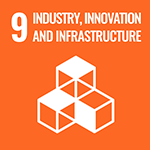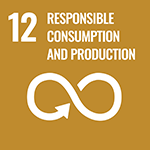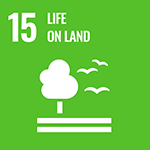We address environmental impact and climate change by reducing our CO₂ emissions, energy consumption, water withdrawal and preserving natural habitats and their biodiversity in the areas surrounding our plants.
The extraction of raw materials - the first step in cement and aggregates production - has an inevitable impact on the surrounding natural and social environment: the soil removal and the consequent changes in the area's topography, which may affect local ecosystems and watersheds.
Minimizing environmental impact is therefore a fundamental priority for Cementir.
The Group extracts a significant part of its raw materials from its own controlled quarries by embracing responsible and sustainable mining principles.
Impacts can be successfully addressed and mitigated through the development and implementation of an effective quarry Rehabilitation and Biodiversity Management Plan, especially in areas of high biodiversity.
In 2024, Cementir Group assessed the impacts, risks and resilience of its business model concerning biodiversity and ecosystems, as quarrying activities could significantly impact biodiversity and ecosystem health due to habitat disruption, dust emissions, and, in certain areas, water resources.
Although, given the abundance and accessibility of raw materials, the Group has not identified significant concerns in terms of business adaptability, an in-depth analysis of biodiversity impacts will be performed in 2025, including site-specific ecological assessments of all company-owned quarries and production sites. This analysis will consider:
- Increasing regulatory focus on biodiversity protection, which may result in stricter permitting requirements, challenges in permit renewals and extensions, and higher operational costs;
- The potential for quarry rehabilitation post-extraction to restore biodiversity, provided that high-standard rehabilitation plans are followed;
- Engaging with stakeholders, including local communities and conservation groups to mitigate reputational risks and enhance ecosystem resilience.
The Group commitment is articulated in three main phases:
- Short-term analysis of risks and opportunities, prioritizing locations based on their potential impact on biodiversity, ensuring compliance with current biodiversity regulations, and the initial implementation of biodiversity action plans.
- Alignment of quarry operations with emerging biodiversity policies (Medium term)
- Execution of the strategy and Roadmap to 2030 in the Long term.
Results will be integrated into the Enterprise Risk Management analysis, to be completed in 2025, with engagement of internal and external stakeholders, along with biodiversity experts and local communities.
Cementir aims to align its business model and strategy with the Kunming-Montreal Global Biodiversity Framework, the EU Biodiversity Strategy for 2030, and relevant global and regional goals and targets.
Cementir Group’s long-term targets are to secure sufficient long term mineral deposits for its operations whilst contributing to the development of more responsible and sustainable resource management strategies.
The Company is committed to the exploration and adoption of alternative resources, significantly reducing CO2 emissions, decreasing reliance on natural resources, and preserving existing reserves.
This approach not only mitigates the need for new extraction sites but also underscores Company’s dedication to innovative and sustainable resource management.
Our commitments:
- Define and implement Rehabilitation Plans for all active sites.
- Biodiversity enhancement recommendations to be integrated as part of Environmental Impact Assessments or Rehabilitation Plans for any new extraction site.
- Assess all extraction sites and identify the sites having high biodiversity value.
- Define and implement a Biodiversity Management Plan for all sites with high biodiversity value.
Our targets:
- Rehabilitation plan in all active sites by 2025: 100%.
- Biodiversity value assessment of active sites by 2030: 100%.
- Biodiversity value assessment of all sites and Biodiversity Management Plan for high biodiversity sites by 2030: 100%.
Quarrying activity management
Before deciding to acquire and open any new quarry, all safety aspects, including impacts on the environment, flora and fauna and water resources are carefully analyzed and planned. We also always evaluate any social impacts and land recovery plans once the quarry is depleted.
Our goal is always to minimize or eliminate any potential negative impact that may occur as a result of quarrying activities, but we also work to increase potential positive impacts where possible.
Part of our work also falls into risk management: we analyze environmental risks to ensure compliance with current regulations and the best environmental standards and Best Available Technique (BAT) and we coordinate so that all the Group's businesses operate with an environmental management system certificate.
With our quarrying activities we link and prioritize three of the United Nations Sustainable Development Goals through the following actions:
 SDG 9: |  SDG 12: |  SDG 15: |
|
|
|
Quarry rehabilitation plan
The post-closure land use needs are clearly assessed when initiating a Rehabilitation Plan, even if this can evolve over the lifetime of the quarry as guaranteeing that the site to be left in safe and stable conditions as a first principle.
Rehabilitation Plan developed along with the mining plan, prior to the commencement of extraction activities with clear set of objectives and measurable targets, reflecting the legislative requirements (as the highest priority), and encompassing the environmental considerations including those also relate to biodiversity and natural capital. An appropriate adaptation of the land is also a guarantee for the success of the revegetation activities, with which it is possible to recover the ecosystem functionality.
Cementir Holding applies progressive rehabilitation as good practice where possible, depending on the specific type of rehabilitation method.
There are several rehabilitation projects that we carry out with particular attention to respecting and restoring biodiversity, such as the ones highlighted below.
Kudsk & Dahl, Denmark:
Kudsk & Dahl, a Cementir's subsidiary producing aggregates in Denmark, is deeply committed to enhancing biodiversity and rehabilitation at its two quarries in Nr. Hostrup and Dybvad. In 2023, it launched a biodiversity and rehabilitation Roadmap, becoming a pioneer in Denmark’s extractive industry. In 2024, the company continued its efforts, transitioning several gravel pits machines from diesel to electric, substantially reducing CO2 emissions, noise, and improving working conditions. Moreover, Kudsk & Dahl hosted local school students for an educational visit, where they built birdhouses, planted seeds, and learned about local birdlife from an ornithological expert .
CCB, Belgium:
CCB, with its depleted quarry in Gaurain, active quarry in Clypot and future quarry in Barry is continuously working on initiatives for enhancing biodiversity. Continuing from its involvement in the 'Life in Quarries Project', CCB is launching new initiatives for this purpose. CCB’s commitment extends beyond the completion of the project, with a focus on maintaining and amplifying biodiversity actions. Upon the finalization of the project, all the commitments listed in the individual charter are framed legally dispensation for protected species granted by Belgian authorities. Each year starting from 2022, a summary annual report has been drawn up in order to list the actions carried out and publish the monitoring indicators. Since 2022, the Group has been in the post-life phase which is a long-term commitment to maintain in-life actions for a period of 15 years.
The Oksenvad gravel pit has been transformed into a natural area and is now open to the public.
Biodiversity management plan
We understand the importance of quarries for biodiversity and for nature conservation. A key priority is to protect and preserve the ecosystems and to contribute to reduce biodiversity loss during the lifecycle of a quarry through good land stewardship, proper planning of quarry activities and rehabilitation process.
We target to develop a biodiversity management plan for all sites sensitive to biodiversity and with high biodiversity value to maintain or improve biodiversity values during the operational and post-closure phases, and to determine risks and opportunities before mining begins.
To achieve this we work in partnership with local stakeholders and external experts.
Projects for quarries rehabilitation, respect for biodiversity, but also for the recovery of excess heat for district heating